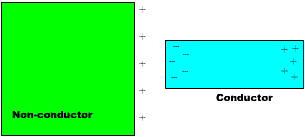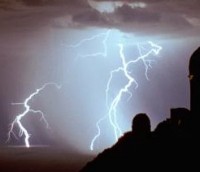|
A spark is a stream of electrons jumping
across an air gap, heating the air until it glows and
expands. Certain conditions can cause enough static
electricity buildup to cause a spark or lightning. A
spark often requires both a conductor and non-conductor.
Lightning is an extreme example of a spark.
Conditions for sparks
Sparks do not happen easily. They are
violent occurrences that require special conditions.
They need both non-conductors and conductors to occur.
The way this happens can get complex. These conditions
include walking on a carpet on a very dry day or the
rapid movement of tiny water particles in a summer
storm.
The Triboelectric Series shows that when
certain materials are in contact, they can cause a great
increase in electrical charges on the surfaces of those
materials. This is typically the case in for sparks that
people personally experience.
Normally water inhibits static
electricity, but in the case of thunderstorms, there is
so much movement of air and water droplets within the
clouds that charges collect on the surface of the
droplets. Enormous amount of charges can collect in the
clouds, some positive ( + ) and some negative ( - ).
You know that static electricity
collects on the surface of non-conductors. But you
seldom�if ever�see a spark fly from one non-conductor to
another. The reason is that sparks need conductors, so
that the electrons can freely move about and gather
enough charges together to be able to jump from one
material to another.
If you took a charged piece of plastic
and put it next to some metal, there would be no spark.
The charges are held on the surface of the plastic, so
that they won't jump the air gap
Another good example of this concerns
how you can get shocked with a spark. You are a
conductor of electricity�although not as good as a piece
of metal. The reason you conduct electricity is because
the of salt in your blood and your cells. Now if you
notice, you usually see sparks when you start to touch
something metal�like a doorknob�or another person or
animal.
So static electricity is formed and
gathered on the surface of a non-conductor, but it must
be then transferred to a conductor to cause a spark.
When a conductor�like a metal rod�is
brought near a charged non-conductor, the free electrons
in the conductor will move to one end or the other of
the rod, depending on whether the non-conductor surface
is positive or negative.

Opposite charges in conductor move
toward non-conductor
When the conductor is brought into
contact with the non-conductor, the electrical charges
on the surface of the non-conductor are "sucked" into
the conductor. In other words, if negative charges are
on the surface of the non-conductor, these electrons
will move into the conductor. If positively charged
atoms are on the surface, electrons from the metal or
conductor will neutralize those atoms, resulting in an
excess of positive charges in the conductor.
Now, if another conductor is brought
near the first conductor, the same thing will happen.
Since electrons can move so freely in a conductor, many
may collect near the surface and actually jump across
the air gap as a spark.
Anatomy of a spark
Air is a non-conductor of electricity
and resists the movement of electrons through it. When
the attraction or electrical pressure is great enough
between objects with positive ( + ) and negative ( - )
charges--or even between a charged object and a neutral
one--some electrons are able to overcome the resistance
and jump the air gap. This electrical pressure is also
called potential difference or voltage difference.
Since air is a non-conductor of
electricity, it does not readily let electrons pass
through it. But if the attraction is great enough, some
electrons will leave their material and fly to the other
object. While they move through the air, may smash into
and bounce off molecules or atoms that are in their way.
This heats up the air. (See Heat for an explanation.)

Spark glows white-hot
Now, the hotter the air is, the less
resistance it gives the electrons. So as the air gets
heated, more and more electrons start jumping over to
the other side. This only heats the air even more, until
it actually gets white-hot. That is the spark or bolt of
lightning that you see and feel.
Once enough electrons have made the
jump, the attraction is reduced and the flow stops. The
spark quickly cools down and the air stops glowing. It
is all over in a fraction of a second. Since this
happens for such a short time, so you may only feel a
slight discomfort from the heat of the spark. But if the
spark is a bolt of lightning, it can cause an enormous
amount of damage.
Lightning works the same way as a little
spark, except that it happens on a massive scale. Some
lightning bolts are several miles long. Compare that to
the tiny 1/4 inch or 1 centimeter length of the spark
that comes off your finger.

Lightning can be quite dramatic
Lightning is created when water drops
are churning around in a thunder cloud. They gather
either positive or negative electrical charges, so that
soon one cloud may be positive and another cloud may be
negative. Or perhaps some object on the earth may have
an excess of opposite charge.
The electrical pressure builds up, the
same way as it does for a spark. Since the distances are
so much greater between the clouds, the electrical
pressure must be extremely high for lightning to start.
But once it does and a lightning bolt jumps from one
cloud to another, it is a tremendous spectacle.
Most lightning bolts are from cloud to
cloud, but sometimes there are no positive charged
clouds nearby, so the negative cloud, sends its
electrons to the ground or any object that may have a
slight positive charge.
Air expands when it is heated and
contract when it cools. Since the spark happens so fast,
the air expands and contracts very rapidly. When it
contracts, the air slaps together, just like when you
clap your hands or pop a balloon. The noise you hear
from a spark is just a snap, because it is so small.
On the other hand, the noise of thunder
is a tremendous crash, because the size of lightning is
so large. The snap of a spark and the crash of thunder
are caused by the same effect. The only difference is in
the size of the spark.
Static electricity is caused when
friction causes electrical charges to build up on a
surface of a non-conduction material. Its explanation
comes from the Atomic Theory of Matter. Static
electricity can cause sparks and other problems, but it
also is useful in pollution control. |